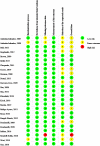Efficacy of flavonoids-containing supplements on insulin resistance and associated metabolic risk factors in overweight and obese subjects: a systematic review and meta-analysis of 25 randomized controlled trials
- PMID: 35937836
- PMCID: PMC9355558
- DOI: 10.3389/fendo.2022.917692
Efficacy of flavonoids-containing supplements on insulin resistance and associated metabolic risk factors in overweight and obese subjects: a systematic review and meta-analysis of 25 randomized controlled trials
Abstract
Background: Obesity is becoming a global epidemic. Flavonoids, with anti-inflammatory and antioxidative functions, are proposed to treat insulin resistance (IR) in obese subjects. We aimed to evaluate the effectiveness and safety of flavonoids-containing supplements on IR and associated metabolic risk factors in overweight and obese participants.
Methods: Randomized controlled trials (RCTs) involving flavonoids-containing supplements used to treat overweight and obese subjects with results of IR, other associated metabolic risk factors, and adverse effects published were retrieved from 5 electronic databases from the year of inception to January 2, 2022.
Results: Twenty-five RCTs (n = 1950) were included. Pooled results demonstrated that HOMA-IR in the group receiving flavonoids-containing supplements significantly decreased versus the control group (WMD = -0.132, 95% CI: -0.236 to -0.027, p = 0.013). Subgroup analyses showed that HOMA-IR in the subgroup receiving flavonoid-containing mixtures significantly decreased (WMD = -0.25, 95% CI: -0.43 to -0.06, p = 0.008), whereas such result was not found in the singly-used flavonoids subgroup (WMD = -0.08, 95% CI: -0.20 to 0.05, p = 0.240). In addition, QUICKI in the experimental group had an increasing trend compared to that in the control group (WMD = 0.01, 95% CI: -0.00 to 0.02, p = 0.065). For secondary outcomes, FBG, FBI, TC, TG, SBP, weight, BMI, and WHR in the group receiving flavonoids-containing supplements dropped significantly compared to those in the controls (WMD = -0.05, 95% CI: -0.08 to -0.02, p = 0.002; WMD = -0.58, 95% CI: -1.04 to -0.12, p = 0.014; WMD = -0.04, 95% CI: -0.06 to -0.03, p < 0.001; WMD = -0.04, 95% CI: -0.05 to -0.03, p < 0.001; WMD = -2.01, 95% CI: -3.17 to -0.86, p = 0.001; WMD = -0.29, 95% CI: -0.49 to -0.09, p = 0.004; WMD = -0.10 95% CI: -0.17 to -0.04, p = 0.003; WMD = -0.10, 95% CI: -0.01 to -0.00, p = 0.015; respectively). Adverse reactions did not differ between the group receiving flavonoids-containing supplements and the control group (RR = 0.97, 95% CI: 0.62 to 1.52, p = 0.905).
Conclusion: This study showed that flavonoids-containing supplements may be efficacious and safe in improving IR and associated metabolic risk factors in overweight and obese participants. Nevertheless, doubt over the findings remains because limited RCTs per type of flavonoids-containing supplement were investigated, and many of the RCTs had a small sample size. Therefore, the findings must be validated in future research.
Systematic review registration: https://inplasy.com/inplasy-2022-2-0011/, identifier INPLASY202220011.
Keywords: Flavonoids; insulin resistance; meta-analysis; obesity; overweight; systematic review.
Copyright © 2022 Yao, Zhang, Zhao, Wang, Lin, Sun, Lu and Fan.
Conflict of interest statement
The authors declare that the research was conducted in the absence of any commercial or financial relationships that could be construed as a potential conflict of interest.
Figures











Similar articles
-
Curcumin effects on glycaemic indices, lipid profile, blood pressure, inflammatory markers and anthropometric measurements of non-alcoholic fatty liver disease patients: A systematic review and meta-analysis of randomized clinical trials.Complement Ther Med. 2024 Mar;80:103025. doi: 10.1016/j.ctim.2024.103025. Epub 2024 Jan 15. Complement Ther Med. 2024. PMID: 38232906
-
Efficacy of vitamin D supplementation on child and adolescent overweight/obesity: a systematic review and meta-analysis of randomized controlled trials.Eur J Pediatr. 2023 Jan;182(1):255-264. doi: 10.1007/s00431-022-04673-8. Epub 2022 Oct 28. Eur J Pediatr. 2023. PMID: 36305951
-
Angiotensin-converting enzyme inhibitors versus angiotensin II receptor blockers on insulin sensitivity in hypertensive patients: A meta-analysis of randomized controlled trials.PLoS One. 2021 Jul 7;16(7):e0253492. doi: 10.1371/journal.pone.0253492. eCollection 2021. PLoS One. 2021. PMID: 34234365 Free PMC article.
-
Beneficial effects of l-carnitine supplementation for weight management in overweight and obese adults: An updated systematic review and dose-response meta-analysis of randomized controlled trials.Pharmacol Res. 2020 Jan;151:104554. doi: 10.1016/j.phrs.2019.104554. Epub 2019 Nov 17. Pharmacol Res. 2020. PMID: 31743774
-
Efficacy and safety of subcutaneous semaglutide in adults with overweight or obese: a subgroup meta-analysis of randomized controlled trials.Front Endocrinol (Lausanne). 2023 Jun 26;14:1132004. doi: 10.3389/fendo.2023.1132004. eCollection 2023. Front Endocrinol (Lausanne). 2023. PMID: 37455913 Free PMC article.
Cited by
-
Artichoke (Cynara scolymus L.) water extract alleviates palmitate-induced insulin resistance in HepG2 hepatocytes via the activation of IRS1/PI3K/AKT/FoxO1 and GSK-3β signaling pathway.BMC Complement Med Ther. 2023 Dec 15;23(1):460. doi: 10.1186/s12906-023-04275-3. BMC Complement Med Ther. 2023. PMID: 38102588 Free PMC article.
-
Gut microbiota in insulin resistance: a bibliometric analysis.J Diabetes Metab Disord. 2024 Feb 14;23(1):173-188. doi: 10.1007/s40200-023-01342-x. eCollection 2024 Jun. J Diabetes Metab Disord. 2024. PMID: 38932838 Free PMC article. Review.
-
Comparative investigation of metabolite signatures and hypoadiposity effect between Dali tea and Yunkang tea.Food Chem X. 2024 Nov 9;24:101989. doi: 10.1016/j.fochx.2024.101989. eCollection 2024 Dec 30. Food Chem X. 2024. PMID: 39629280 Free PMC article.
-
The Impact of Flavonoid Supplementation on Serum Oxidative Stress Levels Measured via D-ROMs Test in the General Population: The PREVES-FLAVON Retrospective Observational Study.Nutrients. 2024 Sep 29;16(19):3302. doi: 10.3390/nu16193302. Nutrients. 2024. PMID: 39408268 Free PMC article.
References
-
- World Health Organization . Obesity and overweight (2019). Available at: https://www.who.int/en/news-room/fact-sheets/detail/obesity-and-overweight (Accessed 25 November 2019).
Publication types
MeSH terms
Substances
LinkOut - more resources
Full Text Sources
Miscellaneous

